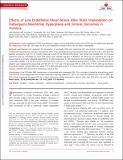Effects of Low Endothelial Shear Stress After Stent Implantation on Subsequent Neointimal Hyperplasia and Clinical Outcomes in Humans
Author(s)
Shishido, Koki; Antoniadis, Antonios P.; Takahashi, Saeko; Tsuda, Masaya; Mizuno, Shingo; Andreou, Ioannis; Papafaklis, Michail I.; Coskun, Ahmet U.; Feldman, Charles L.; Saito, Shigeru; Stone, Peter H.; O'Brien, Caroline C.; Edelman, Elazer R; ... Show more Show less
DownloadEffects of low.pdf (1.116Mb)
PUBLISHER_CC
Publisher with Creative Commons License
Creative Commons Attribution
Terms of use
Metadata
Show full item recordAbstract
Background: In-stent hyperplasia (ISH) may develop in regions of low endothelial shear stress (ESS), but the relationship between the magnitude of low ESS, the extent of ISH, and subsequent clinical events has not been investigated. Methods and Results: We assessed the association of poststent ESS with neointimal ISH and clinical outcomes in patients treated with percutaneous coronary interventions (PCI). Three-dimensional coronary reconstruction was performed in 374 post-PCI patients at baseline and 6 to 10 months follow-up as part of the PREDICTION Study. Each vessel was divided into 1.5-mm-long segments, and we calculated the local ESS within each stented segment at baseline. At follow-up, we assessed ISH and the occurrence of a clinically indicated repeat PCI for in-stent restenosis. In 246 total stents (54 overlapping), 100 (40.7%) were bare-metal stents (BMS), 104 (42.3%) sirolimus-eluting stents, and 42 (17.1%) paclitaxel-eluting stents. In BMS, low ESS post-PCI at baseline was independently associated with ISH (β=1.47 mm 2 per 1-Pa decrease; 95% CI, 0.38-2.56; P < 0.01). ISH was minimal in drug-eluting stents. During follow-up, repeat PCI in BMS was performed in 21 stents (8.5%). There was no significant association between post-PCI ESS and in-stent restenosis requiring PCI. Conclusions: Low ESS after BMS implantation is associated with subsequent ISH. ISH is strongly inhibited by drug-eluting stents. Post-PCI ESS is not associated with in-stent restenosis requiring repeat PCI. ESS is an important determinant of ISH in BMS, but ISH of large magnitude to require PCI for in-stent restenosis is likely attributed to factors other than ESS within the stent.
Date issued
2016-09Department
Institute for Medical Engineering and Science; Harvard University--MIT Division of Health Sciences and TechnologyJournal
Journal of the American Heart Association
Publisher
Ovid Technologies (Wolters Kluwer Health)
Citation
Shishido, Koki, et al. “Effects of Low Endothelial Shear Stress After Stent Implantation on Subsequent Neointimal Hyperplasia and Clinical Outcomes in Humans.” Journal of the American Heart Association, vol. 5, no. 9, Sept. 2016, p. e002949.
Version: Final published version
ISSN
2047-9980
2047-9980